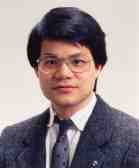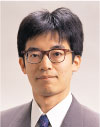|
|
 |
|
|
| Department of Computer Software |
| Image Processing Laboratory |
|
|  |  |  |
| Ryuichi Oka
Professor | Tony Y.T. Chan
Assistant Professor | Yu Nakajima
Research Associate |
|
|
First and foremost, the Image Processing Laboratory engages in research and development of image-based pattern recognition including some areas of Artificial Intelligence, database organization, retrieval, and robotics. More specifically, as can be seen from the background information and the recent research publications of the members of the laboratory, multimedia recognition and retrieval including character recognition of telop in a video image is our current focus.
Related to the recent progress of the web, a huge amount of multimedia data without index becomes available to store in our PC's. However, no sophisticated methodology to manage such data has been developed so far. So that we are solicited to attach an index to each data. Our research aim is to develop algorithms to realize automatic annotation to real word data for integrated retrieval of multimedia information. The algorithms include self-organization and transformation among representation of multimedia and feature extraction and recognition of real data. Real world data includes video, still image, speech, music, sound, and text each of which has not been indexed by labels.
An example of multimedia integration retrieval called "CrossMediator" developed by ten-year project (1992-2002) RWC of METI (Japan). Some parts of Cross Mediator have been in the commercial market by through a private company. Prof. R. Oka was a chief of group which developed "CrossMediator". Our laboratory will pursue to develop more sophisticated functions which might reveal a new generation of the Internet. Speech retrieval system used in CrossMediator is used for developing new types of commercial products.
One of the recent progress is developing a set of algorithms for spotting recognition and tracking objects in a time-varying image. These algorithms enable to realize automatic annotation of video image capturing moving objects.
The Internet is regarded as a network composed of virtual communities. Visualization of the community is becoming an important research target. Our lab is developing a sophisticated algorithm based on so-called Associated hyper-linked word space (A-space). We use the algorithm to detect clusters each of which corresponds a virtual community. Visualization of each virtual community is realized by showing the content extracted from the web pages included the community. |
|
|
|
| [oka-01:2003] | Ryuichi OKA, Takuichi Nishimura, Jian XIN ZHANG, and MasanoriIHARA. Vocabulary-free Speech Retrieval Based on Phoneme Symbol Labeling of Frame Feature Image. Transactions of the Institute of Electronics, Information and Communication Engineers, J86-D-II(6):764-775, 2003.
We have proposed a robust speech retrieval algorithm. Commercial products of software or systems based on the algorithm is becoming popular in a market. |
| [oka-02:2003] | asataka Goto, Hiroki Hashiguchi, and Takuichi Nishimuraand Ryuichi Oka. RWC Music Database: Database of Copyright-Cleared Musical Pieces and Instrument Sounds for Research Purposes. Journal of Information Processing, 45(3):728-738, 2004.
We have developed a large amount of music database to provide world-widely music researchers. This is the first product in the music research field, therefore appreciated strongly by researchers |
|
| Refereed Proceeding Papers |
|
| [oka-03:2003] | H. Kameya, S. Mori, and R. Oka. Figure-Based Writer Verification by Matching between an Arbitrary Part of Registered Sequence and an Input Sequence Extracted from On-Line Handwritten Figures. In International Conference on Document Analysis and Recognition 2003, pages 985-989. IAPR, Aug. 2003.
The proposed algorithm enables a user to use a part of registrated reference sequence as data for his verification. It leads to convenient usage of the verification system for users |
|
|
|
| [oka-04:2003] | Naoki Suto, Takuichi Nishimura, Robert H.Fujii, and RyuichiOKA. Spotting Recognition of Concave and Covex Reference Image with Pixel-wise Correspondence Using Two-dimensional Continuous Dynamic Programing. In Technical Report of IE2003-31,PRMU2003-6, MVE2003-43, pages 23-28. IEICE, July 2003.
The proposed algorithm becomes applicable to realize object tracking in a time-varying image. |
| [oka-05:2003] | Keigo Hirai and Ryuichi OKA. Extraction of image similarity by clustering of word vectors made from attached text and its evaluation. In Technical Report of IE2003-31,PRMU2003-6, MVE2003-43, pages 29-34. IEICE, July 2003.
The proposed method seems promising to link image data with text data each other. |
| [oka-06:2003] | Takeaki Suenaga and Ryuichi OKA. Integration Processing of Extraction of Telop Regions from Video Images and Application of OCR. In Technical Report of IE2003-31,PRMU2003-6, MVE2003-43, pages 13-16. IEICE, July 2003.
The proposed method is solving a challenging problem that shape of telop characters with same categories varies more than the case of handwritten characters. |
|
|
|
| [oka-07:2003] | Ryuichi Oka, Feb. 2004.
Co-chair of program committee, FCV2004.
|
|
|
|
| [oka-08:2003] | Ryuichi Oka.
Video Library of the Upper House started the operation from January. The part of video search by keyword was realized by using CrossMediator developed by R.Oka and Mediadrive Inc. |
| [oka-09:2003] | Ryuichi Oka.
Telphone speech retrieval system was released to the markect by Neix Inc. The system uses the technology developed by R.Oka and Mediadrive Inc. |
|